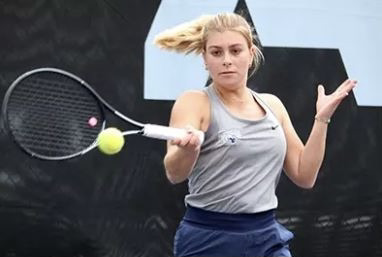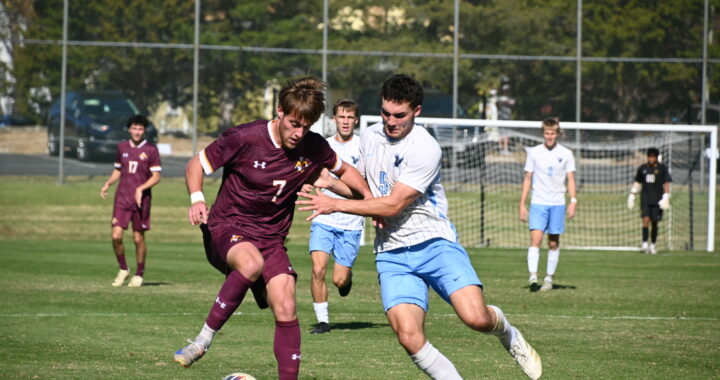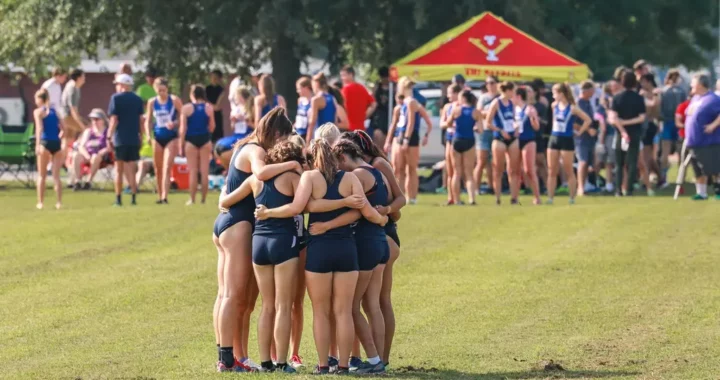Nina Serafin discusses cheer stereotypes and varsity potential
4 min read
UMW Club Cheer
By ABIGAIL BUCHHOLZ
Staff Writer
Ten years ago, a gaggle of fourth graders gathered on the sidelines of a local football game. These girls, members of the B League Knights Cheerleading squad, were about to perform their first ever halftime routine. Each girl had their face painted, knee-high socks and enough glitter to fill a craft shop.
After performing, both sides of the stands erupted in cheers for the girls. At the end of the game each football player gave the girls high fives and hugs, saying they really appreciated their work. This was UMW sophomore Nina Serafin’s, first experience with cheerleading.
With over a decade of cheer under her belt, Serafin cites her sister as her original inspiration for starting cheer. “She just talked about how much she loved it and I thought, ‘I wanna be just like my sister.’”
Throughout her life Serafin has made sacrifices in order to continue pursuing her passion. At one point she lost her job because she prioritized cheer practice over expanding the number of hours she could work. Serafin backed up her decision to continue prioritizing cheer by saying, “It’s something I’ve been doing for so long I feel like I kind of just inspire myself. I’d be disappointed in myself if I quit now.”
Now that she is in college, Serafin has embraced cheerleading wholeheartedly, and is proud to be on such an accredited team. The cheer team has several national titles under its belt, including a first place win at Reach the Beach last year, and a second place win this year.
The team practices for competitions and games three times a week for two to three hours. These practices include intense conditioning such as wall sits and push-ups. On top of this conditioning, push-ups are also used as an incentive during stunting practice, where they are doled out if a stunt group drops their flyer. For these stunts Serafin is the main base, meaning she is positioned to the right side of the flyer, holding her right foot.

When they are not competing the team cheers for both the boys and girls basketball team at UMW. According to Serafin, the lack of a football team at UMW impacts the type of stunts they can perform, “We can’t do the same kinds of stunts or tumbling just because the floors are harder [indoors] and it’s more dangerous. For football the track is a bit softer and you have a bunch of people there to help you in case anything goes wrong.”
As a member of the cheerleading team, Serafin feels as if she is often stereotyped in an unfavorable light, “It’s definitely not something that I fit into anyways, so when people try to classify me in that stereotypes it just kinda gets under my skin.” Serafin does admit that the stereotyping at UMW isn’t as bad as it is at some of the larger schools, like South Carolina, where the cheerleading culture is huge.
In addition to the occasional stereotyping, Serafin feels that the cheer team at UMW faces a problem with recognition, “It feels like people don’t feel like we do a lot, a lot of people don’t even know that we go to competition, a lot of people didn’t know that the team won nationals last year,” said Serafin.
Part of this lack of recognition stems from a lack of understanding of the intensity of the sport. Serafin said, “A lot of people laugh when I say that our routine is two minutes and thirty seconds to three minutes out on the mat, but in reality if other people who didn’t do our sport tried doing what we do and were just thrown into it, to put it quite frankly, they wouldn’t survive. It’s very hard.”
From throwing their fellow teammates into the air to completing mind boggling-flips, the cheer team never slows down.
“People don’t understand the literal blood, sweat and tears that go into this,” said Serafin, citing the concussions and bruises she’s seen as the team catches girls they’ve hurled ten feet in the air.
Some injuries could be prevented, Serafin claims, if another problem is dealt with: the team’s status as a club sport. Because cheerleading isn’t a varsity sport, they aren’t given a personal trainer, a person who Serafin feels would benefit the team and help prevent injuries during practice.
She spoke on several other disadvantages that club sports face. “We don’t get to go to the weight room. We have to reserve the aux gym at the fitness center for practices and sometimes it overlaps with another club sport or varsity sport and we get kicked out.”
Serafin believes that cheerleading should be a varsity sport at UMW due to the titles they have won and the work that the team puts in.
As for the future of cheer at UMW, Serafin has lofty goals, “I hope that it gets bigger and better. I hope that more people want to join whether they’ve never done it before or they have. I hope that we get our recognition, and I hope that after years of trying to become a varsity sport we do, and I hope we have fun while we do it.”


